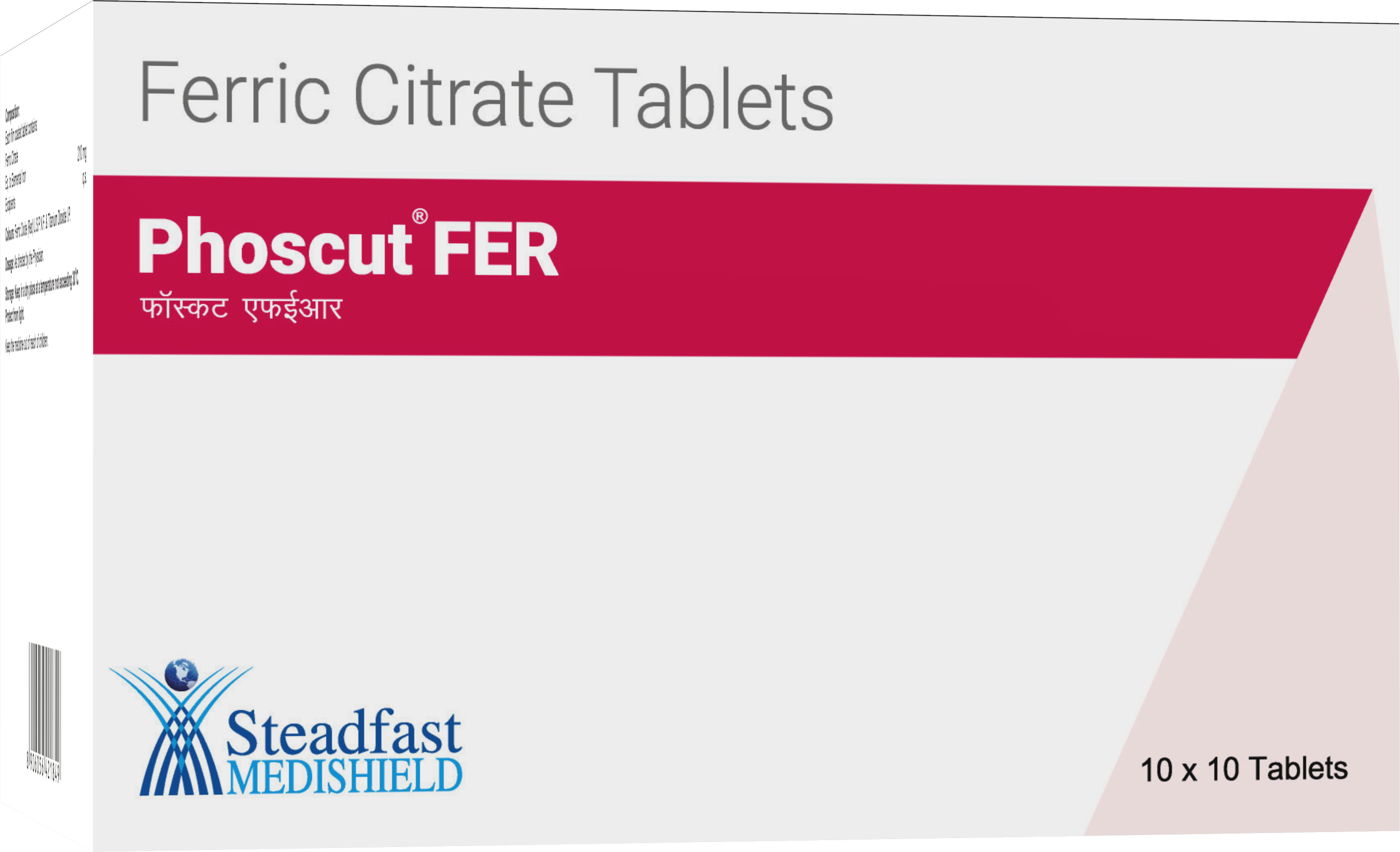Description
Ferric Citrate is known chemically as iron (+3),x(1,2,3-propanetricarboxylic acid,2-hydroxy-),y(H2O). It is used to treat hyperphosphatemia and iron deficiency in CKD patients on haemodialysis or peritoneal dialysis.
Mechanism of Action
Ferric iron binds dietary phosphate in the GI tract and precipitates as ferric phosphate. This compound is insoluble and is excreted in the stool. By binding phosphate in the GI tract and decreasing absorption, ferric citrate lowers the phosphate concentration in the serum.
Pharmacodynamics
In addition to the effects on serum phosphorus levels, Ferric Citrate has been shown to increase serum iron parameters, including ferritin, iron and TSAT. In dialysis patients treated with Ferric Citrate in a 52-week study in which IV iron could also be administered, mean (SD) ferritin levels rose from 593 (293) ng/mL to 895 (482) ng/mL, mean (SD) TSAT levels rose from 31% (11) to 39% (17) and mean (SD) iron levels rose from 73 (29) mcg/dL to 88 (42) mcg/dL. In contrast, in patients treated with active control, these parameters remained relatively constant.
Pharmacokinetics
Absorption and Distribution
Formal pharmacokinetic studies have not been performed with Ferric Citrate. Examination of serum iron parameters has shown that there is systemic absorption of iron from Ferric Citrate.
Drug Interaction Studies
Of the drugs screened for an interaction with ferric citrate in vitro, only doxycycline showed the potential for interaction with at least 70% decrease in its concentration. This interaction can be avoided by spacing the administration of doxycycline and ferric citrate.
Indications and Usage
Ferric Citrate is a phosphate binder indicated for the control of serum phosphorus levels in patients with chronic kidney disease on dialysis.
Dosage and Administration
The recommended starting dose is 2 tablets orally 3 times per day with meals. Serum phosphorus levels should be monitored and the dose of Ferric Citrate titrated in decrements or increments of 1 to 2 tablets per day as needed to maintain serum phosphorus at target levels, up to a maximum dose of 12 tablets daily. Dose can be titrated at 1 week or longer intervals.
Contraindications
Ferric Citrate is contraindicated in patients with iron overload syndromes.
Warnings and Precautions
Iron Overload
Iron absorption from Ferric Citrate may lead to excessive elevations in iron stores. Increases in serum ferritin and transferrin saturation (TSAT) levels were observed in clinical trials. In a 56-week safety and efficacy trial in which concomitant use of Ferric Citrate and IV iron was permitted, 55 (19%) of patients treated with Ferric Citrate had a ferritin level >1500 ng/mL as compared with 13 (9%) of patients treated with active control.
Assess iron parameters (e.g., serum ferritin and TSAT) prior to initiating Ferric Citrate and
monitor iron parameters while on therapy.Patients receiving IV iron may require a reduction in
dose or discontinuation of IV iron therapy.
Assess iron parameters (e.g., serum ferritin and TSAT) prior to initiating Ferric Citrate and monitor iron parameters while on therapy Patients receiving IV iron may require a reduction in dose or discontinuation of IV iron therapy.
Patients with Gastrointestinal Bleeding or Inflammation
Safety in patients with inflammatory bowel disease or active symptomatic gastrointestinal bleeding has not been established.
Use in specific populations
Pregnancy
Pregnancy Category B: There are no adequate and well-controlled studies in pregnant women. It is not known whether Ferric Citrate can cause foetal harm when administered to a pregnant woman.
Labor and Delivery
The effects of Ferric Citrate on labor and delivery are unknown.
Nursing Mothers
Data from rat studies have shown the transfer of iron into milk by divalent metal transporter-1 (DMT-1) and ferroportin-1 (FPN-1). Hence, there is a possibility of infant exposure when Ferric Citrate is administered to a nursing woman.
Paediatric Use
The safety and efficacy of Ferric Citrate have not been established in paediatric patients.
Geriatric Use
Clinical studies of Ferric Citrate included 106 subjects aged 65 years and older (33 subjects aged 75 years and older). Overall, the clinical study experience has not identified any obvious differences in responses between the elderly and younger patients in the tolerability or efficacy of Ferric Citrate.
Over Dosage
No data is available regarding overdose of Ferric Citrate in patients. In patients with chronic kidney disease on dialysis, the maximum dose studied was 2,520 mg ferric iron (12 tablets of Ferric Citrate) per day. Iron absorption from Ferric Citrate may lead to excessive elevations in iron stores, especially when concomitant IV iron is used.
In clinical trials, one case of elevated iron in the liver as confirmed by biopsy was reported in a patient administered IV iron and Ferric Citrate. Because accidental overdose of iron-containing products is a leading cause of fatal poisoning in children under 6 years of age, this product must be kept out of the reach of children. In case of accidental overdose, a doctor or poison control centre should be contacted immediately.
Adverse Reactions
Advise patients that Ferric Citrate may cause discolored (dark) stools, but this staining of the stool is considered normal with oral medications containing iron.
Ferric Citrate may cause diarrhoea, nausea, constipation and vomiting. Advise patients to report severe or persistent gastrointestinal symptoms to their physician.
Presentation
10 tablets packed in a blister, 10 such strips packed in a carton

